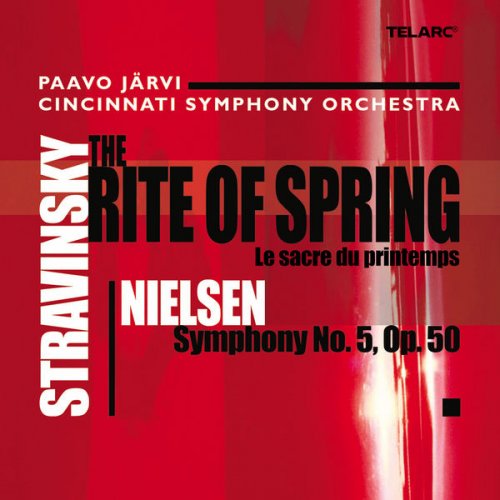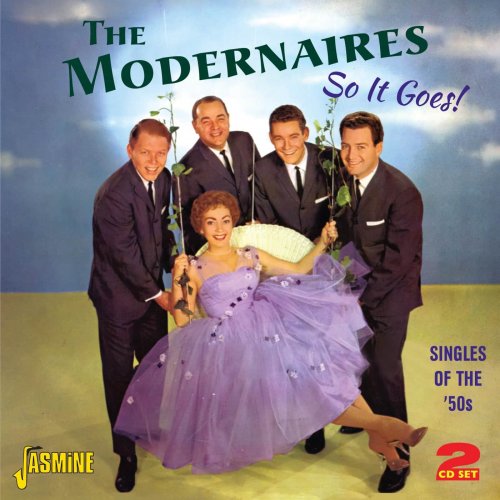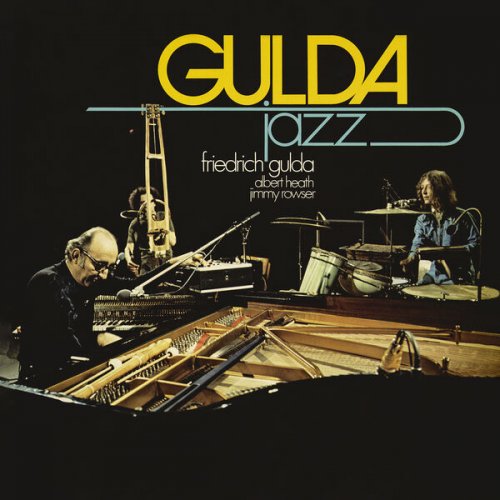Paavo Järvi - Stravinsky: The Rite of Spring - Nielsen: Symphony No. 5, Op. 50 (2022)

Artist: Paavo Järvi, Cincinnati Symphony Orchestra
Title: Stravinsky: The Rite of Spring - Nielsen: Symphony No. 5, Op. 50
Year Of Release: 2004 / 2022
Label: Telarc
Genre: Classical
Quality: FLAC (tracks)
Total Time: 1:13:06
Total Size: 293 MB
WebSite: Album Preview
Tracklist:Title: Stravinsky: The Rite of Spring - Nielsen: Symphony No. 5, Op. 50
Year Of Release: 2004 / 2022
Label: Telarc
Genre: Classical
Quality: FLAC (tracks)
Total Time: 1:13:06
Total Size: 293 MB
WebSite: Album Preview
01. Stravinsky: The Rite of Spring, Pt. 1 "Adoration of the Earth": Introduction
02. Stravinsky: The Rite of Spring, Pt. 1 "Adoration of the Earth": The Harbingers of Spring - Dances of the Young Girls
03. Stravinsky: The Rite of Spring, Pt. 1 "Adoration of the Earth": Game of Abduction
04. Stravinsky: The Rite of Spring, Pt. 1 "Adoration of the Earth": Spring Rounds
05. Stravinsky: The Rite of Spring, Pt. 1 "Adoration of the Earth": Games of Rival Tribes
06. Stravinsky: The Rite of Spring, Pt. 1 "Adoration of the Earth": Procession of the Sage
07. Stravinsky: The Rite of Spring, Pt. 1 "Adoration of the Earth": The Sage
08. Stravinsky: The Rite of Spring, Pt. 1 "Adoration of the Earth": Dance of the Earth
09. Stravinsky: The Rite of Spring, Pt. 2 "The Sacrifice": Introduction
10. Stravinsky: The Rite of Spring, Pt. 2 "The Sacrifice": Mystic Circles of the Young Girls
11. Stravinsky: The Rite of Spring, Pt. 2 "The Sacrifice": Glorification of the Chosen One
12. Stravinsky: The Rite of Spring, Pt. 2 "The Sacrifice": Evocation of the Elders
13. Stravinsky: The Rite of Spring, Pt. 2 "The Sacrifice": Ritual Action of the Elders
14. Stravinsky: The Rite of Spring, Pt. 2 "The Sacrifice": Sacrificial Dance - The Chosen One
15. Nielsen: Symphony No. 5, Op. 50, FS 97: Ia. Tempo giusto
16. Nielsen: Symphony No. 5, Op. 50, FS 97: Ib. Adagio non troppo
17. Nielsen: Symphony No. 5, Op. 50, FS 97: IIa. Allegro
18. Nielsen: Symphony No. 5, Op. 50, FS 97: IIb. Presto
19. Nielsen: Symphony No. 5, Op. 50, FS 97: IIc. Andante un poco tranquillo
20. Nielsen: Symphony No. 5, Op. 50, FS 97: IId. Allegro
Paavo Järvi combines two very different works on his latest Telarc recording and creates a fascinating synergy that is a great example of this conductor’s innovative programming. By bringing together music of two different composers, he leaves the listener to discover the underlying similarities of the two compositions.
Nielsen’s Fifth Symphony, written in 1922, explores the confrontation of two moods, two personalities: the consonant and harmonic versus the dissonant and intense. These opposites have been characterized as the constructive and the destructive. Carl Nielsen’s music spans the boundary between Romanticism and Modernism.
His Fifth Symphony is a direct response to WWI’s effects on the Danish community and an attempt to show the inherent conflict between man’s better instincts and the inclination towards evil. Written in two movements, Nielsen’s Fifth is deceptive as it is divided into four distinct sections. The opening of the first movement is dark and quiet, and second movement builds on the darkness and eventually explodes into the light – an expression of Nielsen’s more optimistic side.
Unlike Nielsen, Stravinsky was a cosmopolitan Russian about to turn Frenchman and eventually American. The Rite of Spring is a transcending work, one that is reflective of a specific time. Like many revolutionary works, the Rite takes its inspiration from extra-musical sources. During the spring of 1910, Stravinsky had a vision: “I saw in my imagination a solemn pagan rite: wise elders, seated in a circle, watching a young girl dance herself to death. They were sacrificing her to propitiate the god of spring.” The Rite is full of simple, folk-like melodies, often with not more than four or five different notes. These tunes are usually accompanied by biting dissonances or shimmering textures.
“To put together these two composers, not usually associated with one another, is to create an interesting symbiosis,” says Järvi in the liner notes. “They are nearly contemporaries, yet they each worked without influence from the other. Their visions of aggression in music were not dissimilar, but their means were different.”
Nielsen’s Fifth Symphony, written in 1922, explores the confrontation of two moods, two personalities: the consonant and harmonic versus the dissonant and intense. These opposites have been characterized as the constructive and the destructive. Carl Nielsen’s music spans the boundary between Romanticism and Modernism.
His Fifth Symphony is a direct response to WWI’s effects on the Danish community and an attempt to show the inherent conflict between man’s better instincts and the inclination towards evil. Written in two movements, Nielsen’s Fifth is deceptive as it is divided into four distinct sections. The opening of the first movement is dark and quiet, and second movement builds on the darkness and eventually explodes into the light – an expression of Nielsen’s more optimistic side.
Unlike Nielsen, Stravinsky was a cosmopolitan Russian about to turn Frenchman and eventually American. The Rite of Spring is a transcending work, one that is reflective of a specific time. Like many revolutionary works, the Rite takes its inspiration from extra-musical sources. During the spring of 1910, Stravinsky had a vision: “I saw in my imagination a solemn pagan rite: wise elders, seated in a circle, watching a young girl dance herself to death. They were sacrificing her to propitiate the god of spring.” The Rite is full of simple, folk-like melodies, often with not more than four or five different notes. These tunes are usually accompanied by biting dissonances or shimmering textures.
“To put together these two composers, not usually associated with one another, is to create an interesting symbiosis,” says Järvi in the liner notes. “They are nearly contemporaries, yet they each worked without influence from the other. Their visions of aggression in music were not dissimilar, but their means were different.”



![Betty Carter - The Music Never Stops (2019) [Hi-Res] Betty Carter - The Music Never Stops (2019) [Hi-Res]](https://www.dibpic.com/uploads/posts/2025-12/1765896843_bcmn500.jpg)
![Milton Man Gogh - Fully Stretched (2025) [Hi-Res] Milton Man Gogh - Fully Stretched (2025) [Hi-Res]](https://www.dibpic.com/uploads/posts/2025-12/1766080588_cover.jpg)



![Travis Jenkins Piano Trio - Jazz in Meanjin 020 (Live at JMI) (2025) [Hi-Res] Travis Jenkins Piano Trio - Jazz in Meanjin 020 (Live at JMI) (2025) [Hi-Res]](https://www.dibpic.com/uploads/posts/2025-12/1765862611_a2068783921_10.jpg)